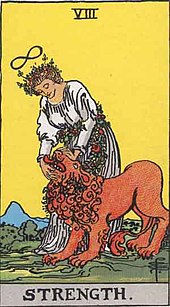Infinity symbol
The infinity symbol (, ∞, or in unicode ∞) is a mathematical symbol representing the concept of infinity. In algebraic geometry, the figure is called a lemniscate.
| ∞ | |
|---|---|
Infinity symbol | |
| In Unicode | U+221E ∞ INFINITY (HTML ∞ · ∞) |
| Different from | |
| Different from | U+267E ♾ PERMANENT PAPER SIGN (HTML ♾) |

History

The shape of a sideways figure eight has a long pedigree; for instance, it appears in the cross of Saint Boniface, wrapped around the bars of a Latin cross.[1] However, John Wallis is credited with introducing the infinity symbol with its mathematical meaning in 1655, in his De sectionibus conicis.[1][2][3][4][5] Wallis did not explain his choice of this symbol, but it has been conjectured to be a variant form of a Roman numeral for 1,000 (originally CIƆ, also CƆ,[6] which was sometimes used to mean "many"), or a variant of the Greek letter ω (omega)—the last letter in the Greek alphabet.[7]

Leonhard Euler used an open variant of the symbol[8] in order to denote "absolutus infinitus". Euler freely performed various operations on infinity, such as taking its logarithm. This symbol is not used anymore, and is not encoded as a separate character in Unicode.
Usage
In mathematics, the infinity symbol is used more often to represent a potential infinity,[1] rather than an actually infinite quantity such as the extended real numbers, the ordinal numbers and the cardinal numbers (which use other notations).[9] For instance, in mathematical expressions with summations and limits such as the one below:
the infinity sign is conventionally interpreted as meaning that the variable grows arbitrarily large towards infinity—rather than actually taking an infinite value.
The infinity symbol may also be used to represent a point at infinity, especially when there is only one such point under consideration. This usage includes, in particular, the infinite point of a projective line,[10][11] and the point added to a topological space to form its one-point compactification .[12]
In areas other than mathematics, the infinity symbol may take on other related meanings. For instance, it has been used in bookbinding to indicate that a book is printed on acid-free paper and will therefore be long-lasting.[13]
Modern symbolism

In modern mysticism, the infinity symbol has become identified with a variation of the ouroboros, an ancient image of a snake eating its own tail that has also come to symbolize the infinite, and the ouroboros is sometimes drawn in figure-eight form to reflect this identification—rather than in its more traditional circular form.[14]
In the works of Vladimir Nabokov, including The Gift and Pale Fire, the figure-eight shape is used symbolically to refer to the Möbius strip and the infinite, as is the case in these books' descriptions of the shapes of bicycle tire tracks and of the outlines of half-remembered people. The poem after which Pale Fire is entitled explicitly refers to "the miracle of the lemniscate".[15]
Graphic design
The well-known shape and meaning of the infinity symbol have made it a common typographic element of graphic design. For instance, the Métis flag, used by the Canadian Métis people since the early 19th century, is based around this symbol.[16] A rainbow-coloured infinity symbol is also used by the neurodiversity movement.[17] In modern commerce, corporate logos featuring this symbol have been used by, among others, the 2022 FIFA World Cup.[18]
Encoding
The symbol is encoded in Unicode at U+221E ∞ INFINITY (HTML ∞ · ∞) [19]and in LaTeX as \infty: .[20]
The Unicode set of symbols also includes several variant forms of the infinity symbol, that are less frequently available in fonts: U+29DC ⧜ INCOMPLETE INFINITY (HTML ⧜ · ⧜ · ISOtech entity ⧜), U+29DD ⧝ TIE OVER INFINITY (HTML ⧝ · ⧝) and U+29DE ⧞ INFINITY NEGATED WITH VERTICAL BAR (HTML ⧞ · ⧞) in block Miscellaneous Mathematical Symbols-B.[21]
References
- Barrow, John D. (2008). "Infinity: Where God Divides by Zero". Cosmic Imagery: Key Images in the History of Science. W. W. Norton & Company. pp. 339–340. ISBN 9780393061772.
- Wallis, John (1655). "Pars Prima". De Sectionibus Conicis, Nova Methodo Expositis, Tractatus (in Latin). pp. 4.
- Scott, Joseph Frederick (1981). The mathematical work of John Wallis, D.D., F.R.S., (1616-1703) (2nd ed.). American Mathematical Society. p. 24. ISBN 0-8284-0314-7.
- Martin-Löf, Per (1990), "Mathematics of infinity", COLOG-88 (Tallinn, 1988), Lecture Notes in Computer Science, 417, Berlin: Springer, pp. 146–197, doi:10.1007/3-540-52335-9_54, MR 1064143
- Cajori, Florian (2007). A History of Mathematical Notations. 1. Cosimo, Inc. p. 214. ISBN 9781602066854.
- "Infinity Symbol and Roman Numerals". www.romannumerals.org. Retrieved 2019-11-15.
- Clegg, Brian (2003). A Brief History of Infinity: The Quest to Think the Unthinkable. Robinson. ISBN 9781841196503.
- See for instance Cor. 1 p. 174 in: Leonhard Euler. Variae observationes circa series infinitas. Commentarii academiae scientiarum Petropolitanae 9, 1744, pp. 160-188.
- "The Definitive Glossary of Higher Mathematical Jargon — Infinite". Math Vault. 2019-08-01. Retrieved 2019-11-15.
- Perrin, Daniel (2007). Algebraic Geometry: An Introduction. Springer. p. 28. ISBN 9781848000568.
- Weisstein, Eric W. "Point at Infinity". mathworld.wolfram.com. Retrieved 2019-11-15.
- Aliprantis, Charalambos D.; Border, Kim C. (2006). Infinite Dimensional Analysis: A Hitchhiker's Guide (3rd ed.). Springer. pp. 56–57. ISBN 9783540295877.
- Zboray, Ronald J.; Zboray, Mary Saracino (2000). A handbook for the study of book history in the United States. Center for the Book, Library of Congress. p. 49. ISBN 9780844410159.
- O'Flaherty, Wendy Doniger (1986). Dreams, Illusion, and Other Realities. University of Chicago Press. p. 243. ISBN 9780226618555. The book also features this image on its cover.
- Toker, Leona (1989). Nabokov: The Mystery of Literary Structures. Cornell University Press. p. 159. ISBN 9780801422119.
- Healy, Donald T.; Orenski, Peter J. (2003). Native American Flags. University of Oklahoma Press. p. 284. ISBN 9780806135564.
- Autistic UK: What is Neurodiversity?
- "Qatar 2022: Football World Cup logo unveiled". Al Jazeera. September 3, 2019.
- AG, Compart. "Unicode Character "∞" (U+221E)". compart.com. Retrieved 2019-11-15.
- "List of LaTeX mathematical symbols - OeisWiki". oeis.org. Retrieved 2019-11-15.
- "Miscellaneous Mathematical Symbols-B" (PDF). Unicode Consortium. Archived (PDF) from the original on 12 November 2018. Retrieved 1 December 2013.